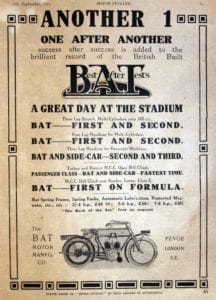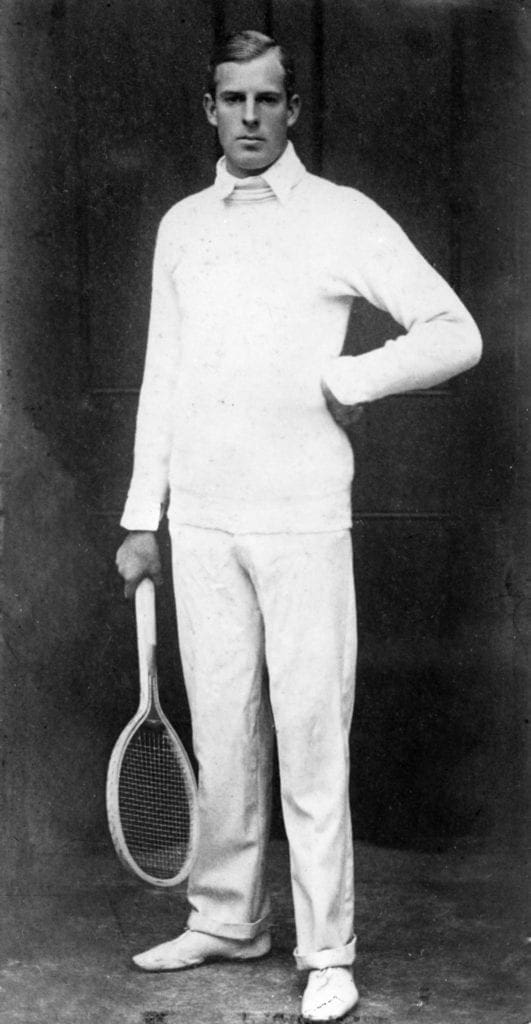You may not have heard of him, but in his day Anthony Wilding was a true pioneer of motorcycling.
What do you do when you lived from the early 90s for nine years in Christchurch, NZ’s Wilding Street and hear in the news that it’s been 100 years ago on the 9th of May 2015, that Kiwi Tennis star Anthony Wilding died as a soldier in battle on 9th of May 1915 at Neuve Chapelle, France in the first World War? Right, you are naturally getting a bit curious about the man in question.
It turns out that Wilding Street was actually named after his father Frederick, a wealthy English immigrant to NZ, and also a keen sportsman in his time and instrumental in establishing Christchurch’s Lancaster Park, later Jade Stadium. The recently reopened tennis facility at Wilding Park is also a reminder of the family legacy.
Enjoy everything MSL by reading the monthly magazine, Subscribe here.
The New Zealand Herald termed Anthony Wilding the Kiwi “Federer” of Wimbledon 100 years ago, a true Tennis hero in his day!
Born on 31 October 1883 at Opawa, Christchurch, his tennis career started at the age of 17 by winning the Canterbury Championships, before moving to the UK to study at Cambridge University. From 1909 onwards, he was a leading world tennis player until 1914 and considered a former World number 1. Wilding won 11 Major titles and was both World Hard Court and World Covered Court champion. He also won the Davis cup four times and won a bronze medal at the 1912 Olympics indoor singles tennis event.
What is much lesser known is that Anthony Wilding was also a very keen motorcyclist and adventurer, predominantly using a BAT sidecar, powered by a JAP 1000cc V-twin engine to travel from one tournament to the next on the European Tennis circuit.
“Anthony just loved motorcycles, they were his favorite toy. He also helped other people keep their motorbikes going”, according to US based actress and director Anna Wilding’s father’s recollection.
Anna: “He was a superstar, a pioneering athlete of the day, which would be a great story to put into a movie about his life at some stage.
A. Wallis Myers in his 1916 published book Captain Anthony Wilding, described his friend as follows: “… Physically a perfect machine himself, he took an absorbing interest in all mechanical contrivances which translated man rapidly from one point to another… for Anthony, a motorcycle was not a convenience, nor a luxury which money could buy… it was a living thing, a companion, a friend. Of fittings and patents he had intimate knowledge, they were like nursery ware… The open road was his highway, oil his food, distance his victim, speed his god… A continuous journey of five hundred miles was an orthodox ride. He would have gone thrice the distance if sea or snow had not intervened”.

But let the man speak for himself. In his book On the Court and Off, published 1912, Anthony Wilding states: “…Motorcycling was more than a hobby to me: It was my method of locomotion, my (superior) substitute for the railway train.
Mr. Punch may liken the motor cyclist to a man who sits in a perpetual draught; but give me the iciest current of fresh air in preference to the stuffy, rebreathed atmosphere of a railway carriage… Of course, there are times when the motor cyclist’s philosophy is strained when, for example, at dead of night, in a strange land and on a broken, disheveled road he may find himself admiring the moon, a burst tyre and complete solitude at the same time… but I defy any man who has brought with him a stout heart and a khaki waterproof to say that the game is not worth the petrol. Believe me, there is only one joy better than flying along a clean, sound French road at forty miles an hour and that is the joy of flying at sixty miles an hour… as a medium for getting from one tournament to another, and that often a thousand miles away, I have found the motorcycle invaluable”.
Anthony’s friend Archie Craig persuaded him in 1908 to join him for the Land’s End to John O’Groats reliability trial. Of the sixty motorcycles taking part in the trial, thirty seven arrived at the finishing line. The average distance was 180 miles per day, with four control points to adhere to. Wilding’s bike behaved amiably, with him not requiring a single stop during the time needed, resulting in gaining a gold medal for the event. Funnily enough, he broke an inlet valve five miles after completing the course.

In 1909, Anthony attended the NZ championships in Nelson, and while his parents returned home by train, he rode the 300 miles over two days back to Christchurch the day after his victory on the tennis court. It was apparently the first time such a journey, amidst several river crossings and bad roads, was undertaken by motorcycle
In March the same year he attended the Akaroa reliability trial, a one hundred and fourteen miles return trip, including a hill-climb competition from Barry’s Bay to Hill Top, which took him eight minutes, thirty nine seconds, half a minute faster than the second machine in the competition. This feat earned him much praise from E. James, the then head of the Dunlop Tyre Company.
In the 1909-10 NZ summer, Anthony rode in just 5 days from Christchurch to Auckland on a 6hp Bat Jap with sidecar passenger Fred Anderson, something not to be sneered at in those days.
The pair on their sidecar outfit went from Opawa across the Port Hills to Lyttelton, then by ship to Wellington, and then northbound a journey of 570 miles over some of the worst roads ever attempted by an intrepid motorcyclist.
But the thirst for distance and speed didn’t end there. In the autumn of 1910, Wilding rode from London to Evian les Bains on Lake Geneva and back on a 7-8 Bat Jap with Phelon & Moore two speed gearbox, a journey of 3000 miles! Following are some snippets of Anthony’s trip in his book’ On the Court and Off’:
“Knowing the usual delay and trouble incurred in obtaining petrol at the other end of a sea journey, I usually take the precaution of filling a beer bottle with petrol and hiding it in my coat. The law says petrol may not be carried in the machine, but a little in a bottle, provided it is well hidden, doesn’t seem to matter”… Belgium is blessed with some of the worst roads in Europe, and from Gent to Antwerp I had some good healthy bumping… A stitch in time saves nine, and heaven knows a turn of the screw wrench time and again saves a nut, and possibly more… if you don’t want to burst your tyre, or pull through your belts, curb your lust for speed on these lengthy French roads.”
He returned to England in October the same year, only to take a trip from London to Constantinople, with fellow Australian lawn tennis player E.O. Pockley as his sidecar passenger. The pair made it as far as Nish, when the roads became impassable, with the outfit in tatters, the bike’s seat broken and the rear wheel buckled.
Myers quotes in his book some contents of postcards Anthony sent to his mother about this trip. Below are some excerpts:
OCT 24: “Broke shaft inside engine today, about twelve miles out of Strasburg. Had to take out and bring in here to get another one made. Done 500 miles, going well. Very interesting journey. Pockley and self very filthy”
NOV 1: “Only about 800 miles from Constantinople. Have covered nearly 2000 miles. Terrific work. Up 6 am, three hours at machine, and rode until dark. Roads passable until today. Now absolutely awful. Only did 50 kilometers. Covered last on railway tracks, bumping over sleepers as roads impassable. Worked so hard no time to write. Will probably chuck it directly, as it rains, rains, rains, making roads impassable”.
Myers commented as follows on Wilding’s motorcycle pursuits:
He knew the physiography of Europe better than most map makers… Nor did he only speed across Europe. He had traversed New Zealand, tested the roads of South Africa and America. I suppose it may truthfully be said that no man has seen so much of the world’s crust from the saddle of a motorcycle…
At this point, it is worth investigating Wilding’s preferred choice of transport. The Bat Jap was built by BAT Motor Manufacturing Co in Penge, London, which produced motorcycles from 1901 to 1925.
The marque was founded by Samuel Batson, a keen cyclist, who became in 1901 interested in motorcycles. He set up shop in 1902 at Kingswood Road to build bikes with initially De Dion engines. In 1903 BAT earned the slogan ‘Best After Test’, from then on powered by MMC engines.

T. H. Tessier joined the firm and took over the business in 1905. He went on to achieve records riding BAT motorcycles in competitions. In 1906 BAT started using JAP, Stevens and Soncin engines for its singles and V-twin road bikes, with the option of either a rigid or sprung frame.
1908 marked a second podium finish for BAT at the TT in the twin-cylinder class. The company had also some success at the Brooklands track. 1909 saw the introduction of BAT racing models, a quadri-cycle and sidecar versions. The company shifted its focus from 1912 to twins, where a counter-shaft gearbox with kick-starter and clutch in the rear hub replaced the trusted two-speed P & M gear.
From 1913 onwards, production of singles was dropped altogether. The company stopped building bikes in 1917 and shifted to producing shell cases. The BAT resurfaced in 1919 with 6hp and 8hp V-twin models with three speeds and chain drive. Tessier’s sons took over the business in 1922, alongside the rights to manufacture Martinsyde twins, later changing its trading name to BAT-Martinsyde. Financial problems in 1925 caused the company to cease production.
Anthony Wilding’s sidecar combination has long been lost to time, hence to illustrate a outfit very similar to Wildings rig, images of a 1912 BAT Jap with sidechair were sourced from Yesterdays Antique Motorcycles in the Netherlands. This sturdy and luxurious 8 hp 1000cc side valve V-twin combination is equipped with ROC two speed gear and is an older restoration. Typical BAT features were a sprung saddle and footboards and a shaft driven magneto that was positioned high and dry.








